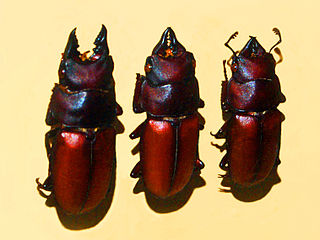The Lucanidae are a family of beetles that include the stag beetles. The family can be further subdivided in a taxonomy. The classification presented here follows Smith (2006), with the exception of the tribal classification within the Lucaninae.

Xerocrassa is a genus of small, air-breathing land snails, terrestrial pulmonate gastropod molluscs in the subfamily Helicellinae of the family Geomitridae.

Prosopocoilus is a genus of beetles of the family Lucanidae.

Scaritinae is a worldwide subfamily of beetles in the family Carabidae, containing more than 2400 species in over 140 genera.
Anomiopus ataenioides is a species of true dung beetle that is endemic to northern Argentina, and is known from Salta, Jujuy, Tucumán and Corrientes provinces. It is believed to share ant colony nests (myrmecophile).
Anomiopus birai is a species of true dung beetle that is known from Caaguazú and Concepción departments of Paraguay, and Mato Grosso do Sul and Mato Grosso states of Brazil. It is found in cerrado savanna at low altitudes, and is a myrmecophile.
Anomiopus idei is a species of true dung beetle that is endemic to Perú, and is only known from its type locality in Loreto Region.
Anomiopus lacordairei is a species of true dung beetle that is endemic to French Guiana, and is only known from Cayenne. It has been recorded from lowland forests, and it may be a myrmecophile.
Anomiopus laetus is a species of true dung beetle that is endemic to Brazil, and is known from Amazonas, Pará and Acre states. It may be a myrmecophile.
Anomiopus nigrocoeruleus is a species of true dung beetle that can be found in Argentina, Brazil and Paraguay. It can be found in cerrado and chaco biomes. It may be a myrmecophile.
Anomiopus parallelus is a species of true dung beetle that can be found in northern Brazil and French Guiana, and can be found in the Amazon and Cerrado biomes. It may be a myrmecophile.
Anomiopus pictus is a species of true dung beetle that can be found in Brazil and Perú. It may be a myrmecophile.
Anomiopus smaragdinus is a species of true dung beetle that can be found in Brazil, French Guiana, Venezuela and Bolivia. It may be a myrmecophile.
Anomiopus soledari is a species of true dung beetle that is endemic to Brazil, and can be found in the Federal District and Goiás State. It can be found in the cerrado biome, and may be a myrmecophile.
Anomiopus virescens is a species of true dung beetle that can be found in Bolivia, Brazil and Paraguay. It can be found in the cerrado biome and surrounding areas, and is likely to be nocturnal and a myrmecophile.
Anomiopus gracilis is a species of true dung beetle that can be found in Brazil and Venezuela.

Coprini is a tribe of scarab beetles, in the dung beetle subfamily (Scarabaeinae). Scholtz et al. describe them as tunnellers that are shiny black, of moderate to large size and with a strongly convex shape. They also, however state that the grouping based on these characteristics has little phylogenetic validity, and the placement of several genera in this and related tribes is likely to change.

Ateuchini is a tribe of dung beetles in the family Scarabaeidae. There are at least 30 genera and 370 described species in Ateuchini.




